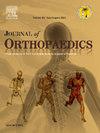用自体骨移植重建无法固定的粉碎性髋臼后壁骨折:系统性综述
IF 1.5
Q3 ORTHOPEDICS
引用次数: 0
摘要
背景髋臼后壁骨折通常由高能量创伤引起,是一种复杂的损伤,给手术带来巨大挑战,尤其是粉碎性骨折。传统的固定技术效果不一,严重的粉碎有时会导致无法固定骨折片。本研究旨在评估自体骨移植重建严重粉碎性不可固定的髋臼后壁骨折的临床和放射学效果。在四个数据库中搜索临床研究:Embase、PubMed、Medline 和 Scopus。采用科尔曼方法评分法对纳入的研究进行了评估。本研究方案已在 PROSPERO 上注册。主要使用自体髂嵴移植物,所有病例均采用 Kocher-Langenbeck 方法。通过 Merle d'Aubigne 和 Harris 髋关节评分评估的临床结果显示,78.9% 的患者表示效果极佳或良好。放射学结果显示,根据 Matta 评分,66% 的患者效果极佳。总体成功率从57%到100%不等,5%的患者转为全髋关节置换术。结论对于年轻患者,自体骨移植治疗粉碎性、不可固定的髋臼后壁骨折可被视为一种潜在的挽救方案,有可能推迟对全髋关节置换术的需求。本文章由计算机程序翻译,如有差异,请以英文原文为准。
Reconstruction of unfixable comminuted posterior wall acetabular fractures with autologous bone graft: A systematic review
Background
Posterior wall acetabular fractures, often caused by high-energy trauma, are complex injuries that pose significant surgical challenges, especially when comminuted. Traditional fixation techniques have shown variable outcomes, with severe comminution sometimes rendering fragment fixation impossible. The aim of this study was to evaluate the clinical and radiological outcomes of autologous bone grafting for reconstructing severely comminuted unfixable posterior wall acetabular fractures.
Materials and methods
A systematic review was conducted in accordance with the PRISMA guidelines. The search for clinical studies was carried out across four databases: Embase, PubMed, Medline, and Scopus. The included studies were evaluated using the Coleman Methodology Score. The present study protocol was registered in PROSPERO.
Results
The study involved 71 patients, with an average age of 37.12 years. Autologous iliac crest grafts were predominantly used, with the Kocher-Langenbeck approach in all cases. Clinical outcomes, assessed by Merle d'Aubigne and Harris Hip Scores, showed 78.9 % of patients reporting excellent to good results. Radiological outcomes indicated 66 % with excellent results per Matta's score. The overall success rate ranged from 57 % to 100 %, with a 5 % conversion to total hip arthroplasty. Complications were reported in 7 % of cases, including nonunion and avascular necrosis.
Conclusion
Autologous bone grafts for comminuted, non-fixable posterior wall acetabular fractures may be considered as a potential salvage option in young patients, potentially delaying the need for THA.
求助全文
通过发布文献求助,成功后即可免费获取论文全文。
去求助
来源期刊

Journal of orthopaedics
ORTHOPEDICS-
CiteScore
3.50
自引率
6.70%
发文量
202
审稿时长
56 days
期刊介绍:
Journal of Orthopaedics aims to be a leading journal in orthopaedics and contribute towards the improvement of quality of orthopedic health care. The journal publishes original research work and review articles related to different aspects of orthopaedics including Arthroplasty, Arthroscopy, Sports Medicine, Trauma, Spine and Spinal deformities, Pediatric orthopaedics, limb reconstruction procedures, hand surgery, and orthopaedic oncology. It also publishes articles on continuing education, health-related information, case reports and letters to the editor. It is requested to note that the journal has an international readership and all submissions should be aimed at specifying something about the setting in which the work was conducted. Authors must also provide any specific reasons for the research and also provide an elaborate description of the results.
 求助内容:
求助内容: 应助结果提醒方式:
应助结果提醒方式:


